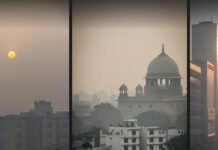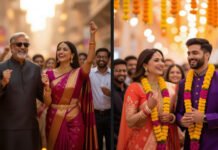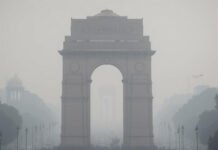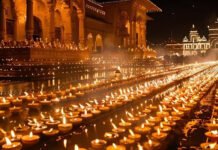New Delhi – The festival of Diwali has taken hold of the entire nation, from the majestic peaks of Kashmir to the coastal landscapes of Kanyakumari. As India’s most anticipated festival, this five-day celebration is marked by the lighting of millions of diyas (lamps), fireworks, and gatherings that symbolize the victory of light over darkness and good over evil. As we dive into the festivities, we explore how Diwali is celebrated in every corner of the country, capturing the unique preparations, rituals, and ceremonies that make this festival truly remarkable.
A Grand Festival Begins: Diwali Celebrations Across Indian Temples
Starting on Wednesday evening, temples across India commenced Deepotsav, or the festival of lights, adding a spiritual layer to the nationwide festivities. Temples have prepared for weeks, illuminating their structures with oil lamps, electric lights, and traditional decorations. In particular, the newly constructed Ram Mandir in Ayodhya is celebrating Diwali for the first time since its consecration, drawing attention and pilgrims from across the nation.
The Iconic Deepotsav at Ayodhya’s Ram Mandir
The celebration in Ram Mandir, Ayodhya, is one of this year’s highlights. After the consecration ceremony of the newly constructed temple, the city marked Diwali with a record-breaking 2.5 million diyas lit across the grounds and surrounding areas. This unprecedented spectacle turned Ayodhya into a sea of lights and set a new record for the number of diyas lit simultaneously. A magnificent procession, featuring colorful tableaux and cultural performances, paraded through the city. This procession was attended by Uttar Pradesh’s Chief Minister Yogi Adityanath, Deputy Chief Ministers Brajesh Pathak and Keshav Prasad Maurya, alongside thousands of enthusiastic spectators.
Prime Minister’s Wishes for Ayodhya’s Historic Diwali
Prime Minister Narendra Modi extended his heartfelt congratulations to Ayodhya on social media, celebrating this significant moment after 500 years. He described the Deepotsav as “unbelievable and grand” and praised the city’s transformation into a spiritual beacon. PM Modi’s message also emphasized the joy and energy that Ayodhya’s Diwali brings to people across the country, wishing all citizens prosperity and divine blessings.
Illuminating Mahakaleshwar: Diwali in Ujjain’s Mahakal Temple
In Madhya Pradesh, the historic Mahakaleshwar Temple in Ujjain celebrated Diwali with a grand Maha Aarti. Known for its intricate rituals and deep-rooted spirituality, the temple’s Diwali celebration included a traditional sparklers aarti performed in the presence of devotees from all around the region. The entire temple complex was adorned with vibrant lights and garlands, creating a breathtaking ambiance that resonated with the festival’s joy.
In Jabalpur, Narmada’s riverbanks witnessed a Diwali extravaganza as 51,000 diyas lined the shores, casting a golden glow over the sacred river. Pilgrims and locals gathered by the river, immersing themselves in prayers, songs, and celebrations honoring the goddess Narmada and seeking her blessings for the year ahead.
Bihar’s Diwali Spectacle: 800,000 Lamps Brighten Kalyanpur
In Bihar, Kalyanpur’s Diwali celebration became a spectacle in itself, as over 800,000 diyas were lit as part of the region’s Deepotsav program. Local residents and temple priests worked tirelessly to create this visual masterpiece, filling the landscape with light and symbolizing hope, harmony, and unity. The overwhelming display brought a surge of pride and joy to Kalyanpur, drawing in visitors from nearby towns and cities.
The Holy Grounds of Mathura and Vrindavan: Diwali at Krishna’s Abode
Diwali celebrations in Mathura and Vrindavan, the land of Lord Krishna, offer an entirely different yet equally enchanting experience. Temples such as the Prem Mandir and Thakur Radha Vallabh Lal Mandir were resplendent with lights, flowers, and fragrant incense, filling the atmosphere with devotion and festivity. The renowned Nandbaba Temple in Nandgaon, however, will celebrate Diwali on November 1, aligning with their unique traditional calendar, allowing devotees a second wave of Diwali celebrations in Krishna’s beloved town.
Diwali at India’s Borders: Soldiers Celebrate in High Spirits
Even on the country’s borders, where our soldiers stand vigilant, Diwali was celebrated with heartfelt warmth. Soldiers from the Indian Army’s Romeo Force, stationed in the challenging terrains of the Pir Panjal Range at 8,000 feet, marked Diwali by lighting diyas and performing rituals that remind them of home. Their display of courage, unity, and patriotism is deeply inspiring, as they celebrate despite the freezing temperatures and challenging conditions. Diwali Rituals and Traditions: A Journey Through India’s Cultural Diversity
Diwali rituals across India vary with region and tradition but share a common purpose: to celebrate life, dispel darkness, and seek blessings. Here’s a glimpse into how different states honor this cherished festival:
1. North India: Homecomings and Gifting
In North India, Diwali is a time for families to reunite and share the joy of the festival with feasts, gift exchanges, and celebrations. Homes are cleaned and decorated, symbolizing a fresh start, and families worship Goddess Lakshmi, the deity of wealth, prosperity, and wisdom. Rangolis made with colorful powders and flower petals decorate entryways, and many households celebrate by hosting elaborate family feasts and pujas.
2. Western India: Business Blessings and Lantern Lighting
In Gujarat and Maharashtra, Diwali is also the beginning of a new financial year. Business owners conduct a special puja in their offices to seek blessings for prosperity and smooth operations in the coming year. The lighting of lanterns and clay diyas outside homes and shops signifies welcoming light and fortune. Cities like Mumbai and Ahmedabad come alive with firecrackers, cultural performances, and delicious Diwali sweets.
3. Eastern India: Kali Puja and Festive Feasts
In West Bengal, Diwali coincides with Kali Puja, a festival that venerates Goddess Kali, symbolizing strength and the destruction of evil. Homes and temples are adorned with lights, and offerings of sweets and fruits are made to Kali. The streets of Kolkata and neighboring regions are illuminated with diyas and elaborate idol decorations. Feasts are prepared for family and friends, emphasizing love and unity.
4. Southern India: Lighting Diyas for Prosperity
In the Southern states, Diwali is often celebrated a day before the North. Families wake up early, don new clothes, and enjoy a variety of festive delicacies. Temples like Meenakshi Temple in Madurai and Sri Venkateswara Temple in Tirupati are illuminated with countless diyas. Pujas for wealth and health are held, and the exchange of sweets between families and neighbors is a prominent part of the tradition.
Festival of Lights: Diwali’s Impact on the Nation’s Spirit
Diwali is a festival that unites India in celebration and gratitude. It’s a time to reflect on the values of kindness, charity, and friendship while embracing the future with hope. This year’s Diwali has been especially memorable, with record-breaking celebrations, first-time festivities in new temples, and the outpouring of joy across villages, towns, and cities.
Whether celebrated in the vibrant lights of Ayodhya’s Ram Mandir, the holy grounds of Ujjain’s Mahakaleshwar, or the distant peaks of the Pir Panjal Range, Diwali’s spirit brings the entire nation together in an unmatched celebration of light, joy, and unity.
















